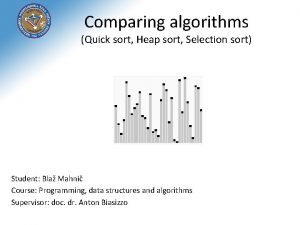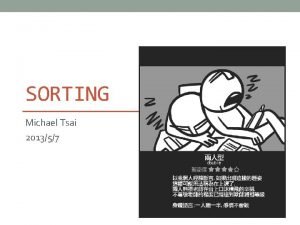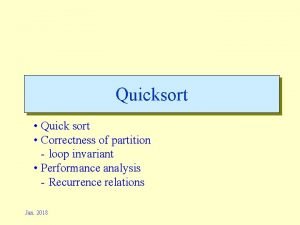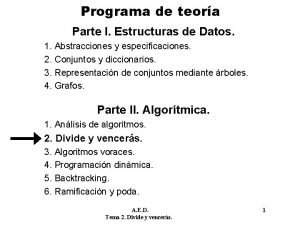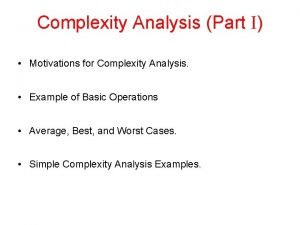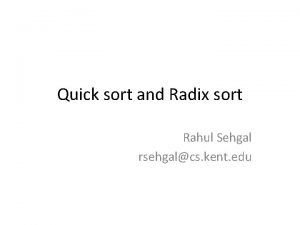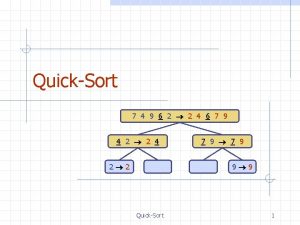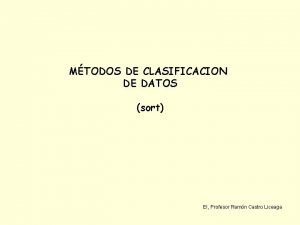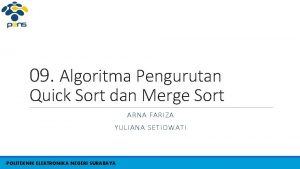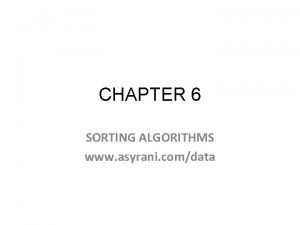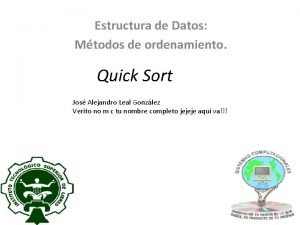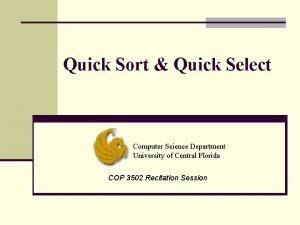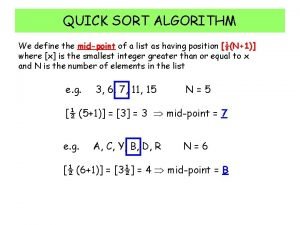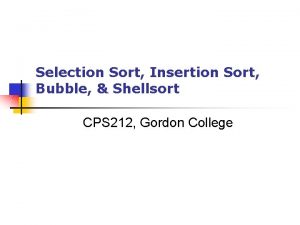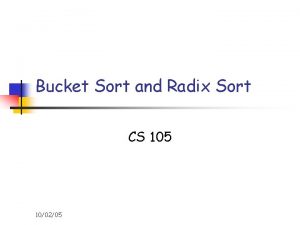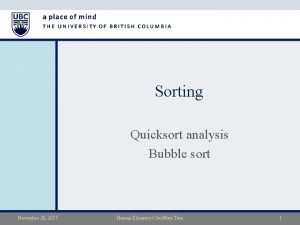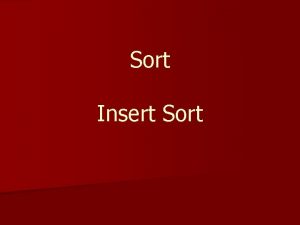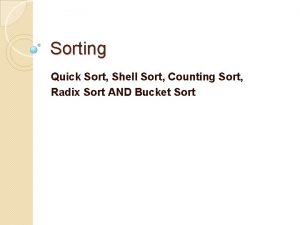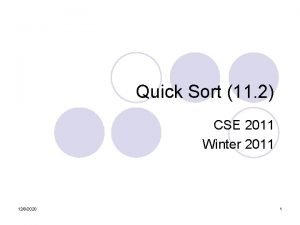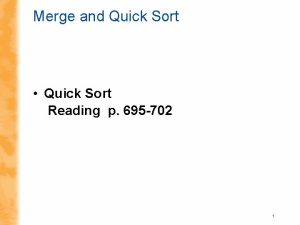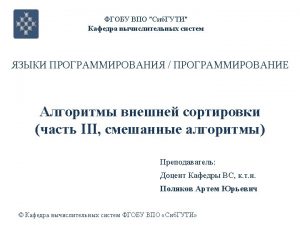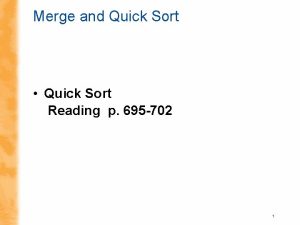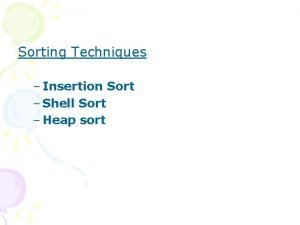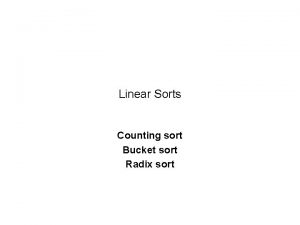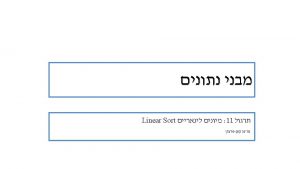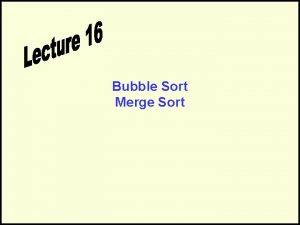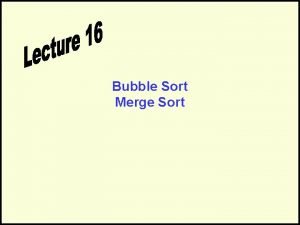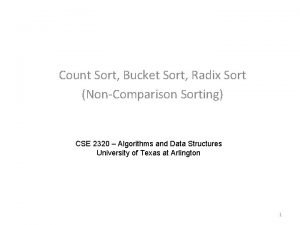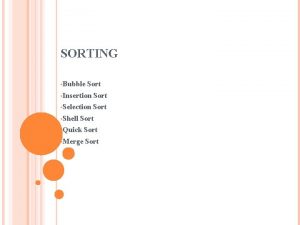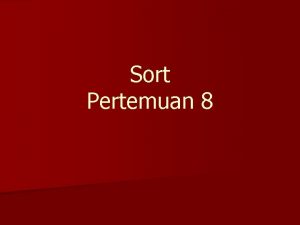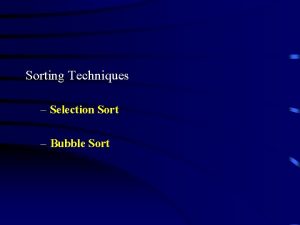Quick Sort 11 2 CSE 2011 Winter 2011






![Partitioning Strategy l Want to partition an array A[left. . right] l First, get Partitioning Strategy l Want to partition an array A[left. . right] l First, get](https://slidetodoc.com/presentation_image_h/09592b3ecf9e80ab7d5ec7a1dc48dca9/image-7.jpg)
![Partitioning Strategy l Want to have pivot ¡ A[k] pivot, for k < i Partitioning Strategy l Want to have pivot ¡ A[k] pivot, for k < i](https://slidetodoc.com/presentation_image_h/09592b3ecf9e80ab7d5ec7a1dc48dca9/image-8.jpg)

![Partitioning Strategy (3) l When i and j have crossed 5 ¡swap A[i] and Partitioning Strategy (3) l When i and j have crossed 5 ¡swap A[i] and](https://slidetodoc.com/presentation_image_h/09592b3ecf9e80ab7d5ec7a1dc48dca9/image-10.jpg)




![Median of Three: Example A[left] = 2, A[center] = 13, A[right] = 6 2 Median of Three: Example A[left] = 2, A[center] = 13, A[right] = 6 2](https://slidetodoc.com/presentation_image_h/09592b3ecf9e80ab7d5ec7a1dc48dca9/image-15.jpg)


![Partitioning Part l Works only if pivot is picked as median-of-three. ¡ A[left] pivot Partitioning Part l Works only if pivot is picked as median-of-three. ¡ A[left] pivot](https://slidetodoc.com/presentation_image_h/09592b3ecf9e80ab7d5ec7a1dc48dca9/image-18.jpg)






- Slides: 24

Quick Sort (11. 2) CSE 2011 Winter 2011 2/22/2021 1

Quick Sort l Fastest known sorting algorithm in practice l Average case: O(N log N) l Worst case: O(N 2) ¡But the worst case can be made exponentially unlikely. l Another divide-and-conquer recursive algorithm, like merge sort 2

Quick Sort: Main Idea 1. If the number of elements in S is 0 or 1, then return (base case). 2. Pick any element v in S (called the pivot). 3. Partition the elements in S except v into two disjoint groups: 1. S 1 = {x S – {v} | x v} 2. S 2 = {x S – {v} | x v} 4. Return {Quick. Sort(S 1) + v + Quick. Sort(S 2)} 3

Quick Sort: Example 4

Example: Quicksort. . . 5

Issues To Consider l How to pick the pivot? l How to partition? ¡ Several methods exist. ¡ The one we consider is known to give good results and to be easy and efficient. 6
![Partitioning Strategy l Want to partition an array Aleft right l First get Partitioning Strategy l Want to partition an array A[left. . right] l First, get](https://slidetodoc.com/presentation_image_h/09592b3ecf9e80ab7d5ec7a1dc48dca9/image-7.jpg)
Partitioning Strategy l Want to partition an array A[left. . right] l First, get the pivot element out of the way by swapping it with the last element (swap pivot and A[right]) l Let i start at the first element and j start at the next-tolast element (i = left, j = right – 1) swap 5 7 4 6 pivot 3 12 19 5 i 7 4 19 3 12 6 j 7
![Partitioning Strategy l Want to have pivot Ak pivot for k i Partitioning Strategy l Want to have pivot ¡ A[k] pivot, for k < i](https://slidetodoc.com/presentation_image_h/09592b3ecf9e80ab7d5ec7a1dc48dca9/image-8.jpg)
Partitioning Strategy l Want to have pivot ¡ A[k] pivot, for k < i ¡ A[k] pivot, for k > j l When i < j j i ¡ Move i right, skipping over elements smaller than the pivot ¡ Move j left, skipping over elements greater than the pivot ¡ When both i and j have stopped l A[i] pivot l A[j] pivot A[i] and A[j] should now be swapped 5 i 7 4 19 3 12 j 6 5 7 i 4 19 3 12 j 6 8

Partitioning Strategy (2) l When i and j have stopped and i is to the left of j (thus legal) ¡ Swap A[i] and A[j] l The large element is pushed to the right and the small element is pushed to the left ¡ After swapping l A[i] pivot l A[j] pivot ¡ Repeat the process until i and j cross swap 5 7 i 4 19 3 12 j 6 5 3 i 4 19 7 12 j 6 9
![Partitioning Strategy 3 l When i and j have crossed 5 swap Ai and Partitioning Strategy (3) l When i and j have crossed 5 ¡swap A[i] and](https://slidetodoc.com/presentation_image_h/09592b3ecf9e80ab7d5ec7a1dc48dca9/image-10.jpg)
Partitioning Strategy (3) l When i and j have crossed 5 ¡swap A[i] and pivot l Result: ¡A[k] pivot, for k < i ¡A[k] pivot, for k > i 3 4 19 7 12 j i 5 3 4 19 7 12 Swap! 5 3 Break! 6 i 4 6 j i 6 j 7 12 19 10

Picking the Pivot l Objective: Choose a pivot so that we will get 2 partitions of (almost) equal size.

Picking the Pivot (2) l Use the first element as pivot ¡ if the input is random, ok. ¡ if the input is presorted (or in reverse order) l all the elements go into S 2 (or S 1). l this happens consistently throughout the recursive calls. l results in O(N 2) behavior (we analyze this case later). l Choose the pivot randomly ¡ generally safe ¡ random number generation can be expensive and does not reduce the running time of the algorithm. 12

Picking the Pivot (3) l Use the median of the array ¡The N/2 th largest element ¡Partitioning always cuts the array into roughly half ¡An optimal quick sort (O(N log N)) ¡However, hard to find the exact median l Median-of-three partitioning ¡ eliminates the bad case for sorted input. ¡ reduces the number of comparisons by 14%. 13

Median of Three Method l Compare just three elements: the leftmost, rightmost and center ¡ Swap these elements if necessary so that l A[left] = Smallest l A[right] = Largest l A[center] = Median of three ¡ Pick A[center] as the pivot. ¡ Swap A[center] and A[right – 1] so that the pivot is at the second last position (why? ) 14
![Median of Three Example Aleft 2 Acenter 13 Aright 6 2 Median of Three: Example A[left] = 2, A[center] = 13, A[right] = 6 2](https://slidetodoc.com/presentation_image_h/09592b3ecf9e80ab7d5ec7a1dc48dca9/image-15.jpg)
Median of Three: Example A[left] = 2, A[center] = 13, A[right] = 6 2 5 6 4 13 3 12 19 2 5 6 4 6 3 12 19 13 Swap A[center] and A[right] 2 5 6 4 6 3 12 19 13 Choose A[center] as pivot 6 pivot 2 5 6 4 19 3 12 6 13 Swap pivot and A[right – 1] pivot We only need to partition A[ left + 1, …, right – 2 ]. Why? 15

Small Arrays l For very small arrays, quick sort does not perform as well as insertion sort l Do not use quick sort recursively for small arrays ¡Use a sorting algorithm that is efficient for small arrays, such as insertion sort. l When using quick sort recursively, switch to insertion sort when the sub-arrays have between 5 to 20 elements (10 is usually good). ¡ saves about 15% in the running time. ¡ avoids taking the median of three when the sub-array has only 1 or 2 elements. 16

Quick Sort: Pseudo-code Choose pivot Partitioning Recursion For small arrays 17
![Partitioning Part l Works only if pivot is picked as medianofthree Aleft pivot Partitioning Part l Works only if pivot is picked as median-of-three. ¡ A[left] pivot](https://slidetodoc.com/presentation_image_h/09592b3ecf9e80ab7d5ec7a1dc48dca9/image-18.jpg)
Partitioning Part l Works only if pivot is picked as median-of-three. ¡ A[left] pivot and A[right] pivot ¡ Need to partition only A[left + 1, …, right – 2] l j will not run past the beginning ¡ because A[left] pivot l i will not run past the end ¡ because A[right-1] = pivot 18

Quick Sort Faster Than Merge Sort l Both quick sort and merge sort take O(N log N) in the average case. l Why is quicksort faster than merge sort? ¡The inner loop consists of an increment/decrement (by 1, which is fast), a test and a jump. ¡There is no extra juggling as in merge sort. inner loop 19

Analysis l Assumptions: ¡A random pivot (no median-of-three partitioning) ¡No cutoff for small arrays l Running time ¡pivot selection: constant time, i. e. O(1) ¡partitioning: linear time, i. e. O(N) ¡running time of the two recursive calls l T(N)= T(i) + T(N – i – 1) + c. N ¡i: number of elements in S 1 ¡c is a constant 20

Worst-Case Scenario l What will be the worst case? ¡The pivot is the smallest element, all the time ¡Partition is always unbalanced 21

Best-Case Scenario l What will be the best case? ¡Partition is perfectly balanced. ¡Pivot is always in the middle (median of the array). 22

Average-Case Analysis l Assume that each of the sizes for S 1 is equally likely has probability 1/N. l This assumption is valid for the pivoting and partitioning strategy just discussed (but may not be for some others), l On average, the running time is O(N log N). l Proof: pp 272– 273, Data Structures and Algorithm Analysis by M. A. Weiss, 2 nd edition 23

Next time … l Arrays (review) l Linked Lists (3. 2, 3. 3) l Stacks, queues (Chapter 5) 24
 Quick sort vs selection sort
Quick sort vs selection sort Quick sort merge sort
Quick sort merge sort Quick sort merge sort
Quick sort merge sort Quick find algorithm
Quick find algorithm The fan blade is speeding up. what are the signs of
The fan blade is speeding up. what are the signs of Quick sort
Quick sort Quicksort invariant
Quicksort invariant Quick sort
Quick sort Quick sort iterative
Quick sort iterative Complexity analysis examples
Complexity analysis examples Quick sort
Quick sort Is quick sort in place
Is quick sort in place Quick sort
Quick sort Algoritma quick sort
Algoritma quick sort Quick sort worst complexity
Quick sort worst complexity Worst case quicksort
Worst case quicksort Quick sort
Quick sort Quick select sort
Quick select sort Selection sort demo
Selection sort demo Quick sort on linked list
Quick sort on linked list Quick sort algorithm
Quick sort algorithm Quick sort algorithm with example
Quick sort algorithm with example Difference between selection sort and bubble sort
Difference between selection sort and bubble sort Bucket sort vs radix sort
Bucket sort vs radix sort Bubble sort vs selection sort
Bubble sort vs selection sort
